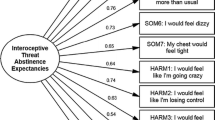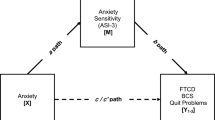Abstract
Background
Although rates of cigarette smoking have declined in the United States (US), individuals experiencing affective vulnerabilities (e.g., anxiety, depression) have maintained high rates of smoking. Extant work has shown distress tolerance and anxiety sensitivity underpin both emotional disorders and smoking. Yet, limited work has evaluated the concurrent and simultaneous role of distress tolerance and anxiety sensitivity on smoking-related processes such as problems when attempting to quit smoking and perceived barriers for cessation.
Methods
Participants included 155 (Mage = 29.59 years; SD = 7.49; 69% male) adults seeking treatment for smoking cessation and low distress tolerance.
Results
Results indicated that only anxiety sensitivity was associated with problems when attempting to quit smoking. Distress tolerance and anxiety sensitivity were each associated with perceived barriers for cessation, with stronger relations for the impact of distress tolerance.
Conclusions
The current findings help elucidate the individual effects of distress tolerance and anxiety sensitivity in one overarching smoking model, thereby refining our understanding of these transdiagnostic factors in terms of clinically-relevant smoking processes.
Similar content being viewed by others
Data Availability
The datasets generated during and/or analyzed during the current study are available from the corresponding author on reasonable request.
References
Bauer, T., Göhlmann, S., & Sinning, M. (2007). Gender differences in smoking behavior. Health Economics, 16(9), 895–909.
Bornovalova, M. A., Gratz, K. L., Daughters, S. B., Hunt, E. D., & Lejuez, C. W. (2012). Initial RCT of a distress tolerance treatment for individuals with substance use disorders. Drug and Alcohol Dependence, 122(1–2), 70–76. https://doi.org/10.1016/j.drugalcdep.2011.09.012.
Brown, R. A., Lejuez, C., Kahler, C. W., & Strong, D. R. (2002). Distress tolerance and duration of past smoking cessation attempts. Journal of abnormal psychology, 111(1), 180.
Brown, R. A., Reed, K. M., Bloom, E. L., Minami, H., Strong, D. R., Lejuez, C. W., Kahler, C. W., Zvolensky, M. J., Gifford, E. V., & Hayes, S. C. (2013). Development and preliminary randomized controlled trial of a distress tolerance treatment for smokers with a history of early lapse. Nicotine & Tobacco Research, 15(12), 2005–2015. https://doi.org/10.1093/ntr/ntt093.
Cohen, J. (1988). Statistical power analysis for the behavioral sciences. Abingdon. England: Routledge.
Cornelius, M. E., Loretan, C. G., Wang, T. W., Jamal, A., & Homa, D. M. (2022). Tobacco product use among adults - United States, 2020. Mmwr. Morbidity And Mortality Weekly Report, 71(11), 397–405. https://doi.org/10.15585/mmwr.mm7111a1.
Farris, S. G., Leyro, T. M., Allan, N. P., Øverup, C. S., Schmidt, N. B., & Zvolensky, M. J. (2016). Distress intolerance during smoking cessation treatment. Behaviour Research And Therapy, 86, 33–42.
Garey, L., Jardin, C., Kauffman, B. Y., Sharp, C., Neighbors, C., Schmidt, N. B., & Zvolensky, M. J. (2017). Psychometric evaluation of the Barriers to Cessation Scale. Psychological assessment, 29(7), 844.
Garey, L., Peraza, N., Smit, T., Mayorga, N. A., Neighbors, C., Raines, A. M., Schmidt, N. B., & Zvolensky, M. J. (2018). Sex differences in smoking constructs and abstinence: The explanatory role of smoking outcome expectancies. Psychology Of Addictive Behaviors, 32(6), 660–669. https://doi.org/10.1037/adb0000391.
Garey, L., Smit, T., Neighbors, C., Gallagher, M. W., & Zvolensky, M. J. (2021). Personalized feedback for smoking and anxiety sensitivity: A Randomized Controlled Trial. Substance use & misuse, 1–12.
Guillot, C. R., Pang, R. D., & Leventhal, A. M. (2014). Anxiety sensitivity and negative urgency: A pathway to negative reinforcement-related smoking expectancies. Journal of addiction medicine, 8(3), 189–194. https://doi.org/10.1097/adm.0000000000000017.
Hall, S. M., Humfleet, G. L., Gorecki, J. A., Muñoz, R. F., Reus, V. I., & Prochaska, J. J. (2008). Older versus younger treatment-seeking smokers: Differences in smoking behavior, drug and alcohol use, and psychosocial and physical functioning. Nicotine & Tobacco Research, 10(3), 463–470.
Korte, K. J., Capron, D. W., Zvolensky, M., & Schmidt, N. B. (2013). The Fagerström test for nicotine dependence: Do revisions in the item scoring enhance the psychometric properties? Addictive behaviors, 38(3), 1757–1763.
Kraemer, K. M., McLeish, A. C., Jeffries, E. R., Avallone, K. M., & Luberto, C. M. (2013). Distress tolerance and perceived barriers to smoking cessation. Substance Abuse, 34(3), 277–282. https://doi.org/10.1080/08897077.2013.771597.
Leventhal, A. M., & Zvolensky, M. J. (2015). Anxiety, depression, and cigarette smoking: A transdiagnostic vulnerability framework to understanding emotion-smoking comorbidity. Psychological Bulletin, 141(1), 176–212. https://doi.org/10.1037/bul0000003.
Leyro, T. M., Zvolensky, M. J., Vujanovic, A. A., & Bernstein, A. (2008). Anxiety sensitivity and smoking motives and outcome expectancies among adult daily smokers: Replication and extension. Nicotine & Tobacco Research, 10(6), 985–994. https://doi.org/10.1080/14622200802097555.
Leyro, T. M., Zvolensky, M. J., & Bernstein, A. (2010). Distress tolerance and psychopathological symptoms and disorders: A review of the empirical literature among adults. Psychological Bulletin, 136(4), 576–600. https://doi.org/10.1037/a0019712.
Leyro, T. M., Bernstein, A., Vujanovic, A. A., McLeish, A. C., & Zvolensky, M. J. (2011). Distress tolerance scale: A confirmatory factor analysis among daily cigarette smokers. Journal of Psychopathology and Behavioral Assessment, 33(1), 47–57. https://doi.org/10.1007/s10862-010-9197-2.
Macnee, C. L., & Talsma, A. (1995). Development and testing of the barriers to cessation scale. Nursing research, 44(4), 214–219.
McHugh, R. K., Votaw, V. R., Fulciniti, F., Connery, H. S., Griffin, M. L., Monti, P. M., & Weiss, R. D. (2017). Perceived barriers to smoking cessation among adults with substance use disorders. Journal Of Substance Abuse Treatment, 74, 48–53. https://doi.org/10.1016/j.jsat.2016.12.008.
McLeish, A. C., Johnson, A. L., Avallone, K. M., & Zvolensky, M. J. (2016). Evaluating the role of anxiety sensitivity in barriers to cessation and reasons for quitting among smokers with asthma. Psychology, Health And Medicine, 21(2), 236–247. https://doi.org/10.1080/13548506.2015.1051058.
Otto, M. W., Eastman, A., Lo, S., Hearon, B. A., Bickel, W. K., Zvolensky, M., Smits, J. A., & Doan, S. N. (2016). Anxiety sensitivity and working memory capacity: Risk factors and targets for health behavior promotion. Clinical Psychology Review, 49, 67–78. https://doi.org/10.1016/j.cpr.2016.07.003.
OʼCleirigh, C., Zvolensky, M. J., Smits, J. A. J., Labbe, A. K., Coleman, J. N., Wilner, J. G., Stanton, A. M., Gonzalez, A., Garey, L., Regenauer, K. S., & Rosenfield, D. (2018). Integrated Treatment for Smoking Cessation, anxiety, and Depressed Mood in People living with HIV: A Randomized Controlled Trial. Journal Of Acquired Immune Deficiency Syndromes, 79(2), 261–268. https://doi.org/10.1097/qai.0000000000001787.
Park, S., Lee, J. Y., Song, T. M., & Cho, S. I. (2012). Age-associated changes in nicotine dependence. Public Health, 126(6), 482–489. https://doi.org/10.1016/j.puhe.2012.02.007.
Perkins, K. A., Karelitz, J. L., Giedgowd, G. E., Conklin, C. A., & Sayette, M. A. (2010). Differences in negative mood-induced smoking reinforcement due to distress tolerance, anxiety sensitivity, and depression history. Psychopharmacology (Berl), 210(1), 25–34. https://doi.org/10.1007/s00213-010-1811-1.
Redmond, B. Y., Salwa, A., Bricker, J. B., Buckner, J. D., Garey, L., & Zvolensky, M. J. (under review). Personalized feedback intervention for individuals with low distress tolerance who smoke cigarettes: A randomized controlled trial of a digital intervention. Journal of Substance Use and Addiction Treatment.
Reiss, S., & McNally, R. J. (1985). Expectancy model of fear-theoretical issues in behavior therapy. In S. Reiss, & R. R. Bootsin (Eds.), Theoretical issues in behavior therapy (pp. 107–121). 107–121). Academic Press.
Schlam, T. R., Baker, T. B., Smith, S. S., Cook, J. W., & Piper, M. E. (2020). Anxiety sensitivity and distress tolerance in smokers: Relations with Tobacco Dependence, Withdrawal, and quitting Success†. Nicotine & Tobacco Research, 22(1), 58–65. https://doi.org/10.1093/ntr/ntz070.
Simons, J. S., & Gaher, R. M. (2005). The distress tolerance scale: Development and validation of a self-report measure. Motivation and emotion, 29(2), 83–102.
Trinidad, D. R., Pérez-Stable, E. J., White, M. M., Emery, S. L., & Messer, K. (2011). A nationwide analysis of US racial/ethnic disparities in smoking behaviors, smoking cessation, and cessation-related factors. American journal of public health, 101(4), 699–706.
Trujillo, M. A., Khoddam, R., Greenberg, J. B., Dyal, S. R., Ameringer, K. J., Zvolensky, M. J., & Leventhal, A. M. (2015). Distress tolerance as a Correlate of Tobacco Dependence and Motivation: Incremental Relations over and above anxiety and depressive symptoms. Behavioral medicine, 1–9. https://doi.org/10.1080/08964289.2015.1110559.
Veilleux, J. C. (2019). The relationship between distress tolerance and cigarette smoking: A systematic review and synthesis. Clinical Psychology Review, 71, 78–89. https://doi.org/10.1016/j.cpr.2019.01.003.
Zvolensky, M. J., & Leventhal, A. M. (2016). Affect and Health Behavior Co-Occurrence: The emerging roles of transdiagnostic factors and sociocultural factors. Behavior Modification, 40(1–2), 3–6. https://doi.org/10.1177/0145445515627307.
Zvolensky, M. J., Lejuez, C., Kahler, C. W., & Brown, R. A. (2003). Integrating an interoceptive exposure-based smoking cessation program into the cognitive-behavioral treatment of panic disorder: Theoretical relevance and case demonstration. Cognitive and Behavioral Practice, 10(4), 347–357.
Zvolensky, M. J., Vujanovic, A. A., Miller, M. O. B., Bernstein, A., Yartz, A. R., Gregor, K. L., McLeish, A. C., Marshall, E. C., & Gibson, L. E. (2007). Incremental validity of anxiety sensitivity in terms of motivation to quit, reasons for quitting, and barriers to quitting among community-recruited daily smokers. Nicotine & Tobacco Research, 9(9), 965–975.
Zvolensky, M. J., Bernstein, A., Yartz, A. R., McLeish, A. C., & Feldner, M. T. (2008). Cognitive-behavioral treatment of co-morbid panic psychopathology and tobacco use and dependence. Anxiety and substance use disorders: The vicious cycle of comorbidity, 177–200.
Zvolensky, M. J., Paulus, D. J., Langdon, K. J., Robles, Z., Garey, L., Norton, P. J., & Businelle, M. S. (2017). Anxiety sensitivity explains associations between anxious arousal symptoms and smoking abstinence expectancies, perceived barriers to cessation, and problems experienced during past quit attempts among low-income smokers. Journal of Anxiety Disorders, 48, 70–77. https://doi.org/10.1016/j.janxdis.2016.12.003.
Zvolensky, M. J., Garey, L., Fergus, T. A., Gallagher, M. W., Viana, A. G., Shepherd, J. M., Mayorga, N. A., Kelley, L. P., Griggs, J. O., & Schmidt, N. B. (2018a). Refinement of anxiety sensitivity measurement: The short scale anxiety sensitivity index (SSASI). Psychiatry research, 269, 549–557.
Zvolensky, M. J., Rosenfield, D., Garey, L., Kauffman, B. Y., Langdon, K. J., Powers, M. B., Otto, M. W., Davis, M. L., Marcus, B. H., Church, T. S., Frierson, G. M., Hopkins, L. B., Paulus, D. J., Baird, S. O., & Smits, J. A. J. (2018b). Does exercise aid smoking cessation through reductions in anxiety sensitivity and dysphoria? Health Psychology, 37(7), 647–657. https://doi.org/10.1037/hea0000588.
Funding
Research reported in this publication was supported by a pre-doctoral National Research Service Award awarded from the National Institute on Drug Abuse (NIDA) to Dr. Brooke Redmond (F31-DA046127). This work was also supported by the National Institute on Minority Health and Health Disparities (NIMHD) of the National Institutes of Health (NIH) to the University of Houston under Award Number U54MD015946. The content is solely the responsibility of the authors and does not necessarily represent the official views of the National Institutes of Health.
Author information
Authors and Affiliations
Corresponding author
Ethics declarations
Ethics Approval
All procedures performed in studies involving human participants were in accordance with the ethical standards of the institutional and/or national research committee and with the 1964 Helsinki Declaration and its later amendments or comparable ethical standards. The study was approved by the Institutional Review Board of the University of Houston (No. STUDY00000686).
Conflict of Interest
The authors declare that they have no conflict of interest.
Consent to Participate
Informed consent was obtained from all individual participants included in the study.
Consent to Publish
Patients provided informed consent regarding publishing their data.
Additional information
Publisher’s Note
Springer Nature remains neutral with regard to jurisdictional claims in published maps and institutional affiliations.
Electronic Supplementary Material
Below is the link to the electronic supplementary material.
Rights and permissions
Springer Nature or its licensor (e.g. a society or other partner) holds exclusive rights to this article under a publishing agreement with the author(s) or other rightsholder(s); author self-archiving of the accepted manuscript version of this article is solely governed by the terms of such publishing agreement and applicable law.
About this article
Cite this article
Redmond, B.Y., Salwa, A., Bizier, A. et al. Evaluating Distress Tolerance and Anxiety Sensitivity as Simultaneous and Concurrent Transdiagnostic Risk Factors for Smoking Quit Problems and Perceived Barriers for Cessation. Cogn Ther Res 47, 834–840 (2023). https://doi.org/10.1007/s10608-023-10401-9
Accepted:
Published:
Issue Date:
DOI: https://doi.org/10.1007/s10608-023-10401-9




